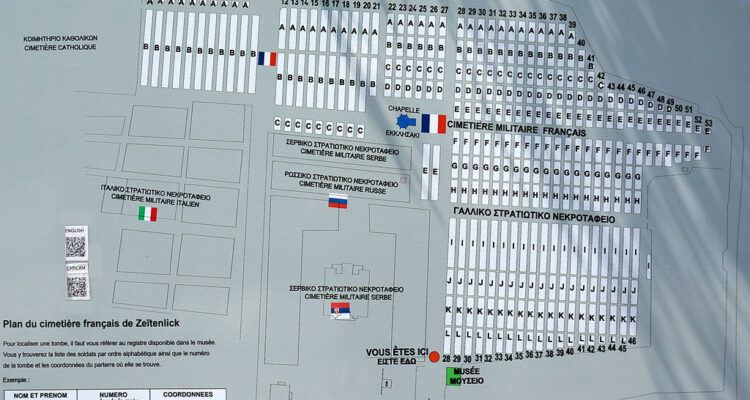The Allied Cemeteries of Zeïtenlick (French: Cimetière militaire de Zeïtenlick, Serbian: Српско варочко гробље на Зейтинлику) in the Ampelokipi Gardens of Thessaloniki is the largest military necropolis in the country, where 20,500 Allied soldiers of the Entente, who fought on the Macedonian Front during the First World War, are buried. It is located on Lagada Street, about one and a half kilometers north of Vardaris Square.
As the First World War progressed and the “Macedonian Front” took shape, part of the allied forces were deployed around the city of Thessaloniki, while needs arose to “cover the increased burial needs due to the war”.
Zeitenlik seemed to meet the necessary specifications, given that “the burial of the dead, from ancients times till the beginning of the 20th century, took place, with few exceptions, “extra muros” (outside the city walls)”. According to the assessment of Mr. Nigdelis, the presence of the adjacent small cemetery of Saints Vincent and Paul, the conversion of the Lazarist buildings into a military hospital and the agreement of all the allied forces to find a common burial place for all, including those who fell in during the war.
And as of today, 20,500 Entente soldiers rest in Zeitenlik’s allied cemeteries. Among them are 8089 French, 7500 Serbs, 3000 Italians, 1600 British, 400 Russians and 39 Bulgarians. Moreover, given that the allied forces during hostilities used colonial military forces, it is known that among the 8089 French people are also 1222 people from Senegal, 398 from Madagascar and Indochina and 343 North Africans.
During the war operations, the area was used to bury those who died in the war, however the agreement to establish a common cemetery was signed in November 1918 by the military authorities of Greece, France, England, Serbia and Italy. The Greek government bought the required lands, while the costs of construction and maintenance of the site were borne by the English, French, Italian and Serbian governments, according to Article 4 of Law 2473 of 1920.
“Death knows no divisions”
Today, the cemetery is divided into five sectors, depending on the nationality of the fallen. The graves of the Serbs, French and Italians have simple crosses on them, while in the English sector there are rectangular slabs with carved crosses above the graves. In the French sector, the visitor can read on the graves the indication M for the warriors from Madagascar, S for those who came from Senegal, upside down A for the graves of Tunisians and Moroccans, and the Star of David for the Jewish graves. It is, after all, this characteristic of the coexistence of so many different people that, according to the historian and author Konstantinos Nigdelis, gave Thessaloniki the nicknames Balkan Marseille, sea pearl of the East, cosmopolitan anthill, vast camp where all the tribes of Israel nest, newspaper Babel et al.
Copyright 2023 © Created By Diadyktio, All Rights Reserved.
To provide the best experiences, we and our partners use technologies like cookies to store and/or access device information. Consenting to these technologies will allow us and our partners to process personal data such as browsing behavior or unique IDs on this site and show (non-) personalized ads. Not consenting or withdrawing consent, may adversely affect certain features and functions.
Click below to consent to the above or make granular choices. Your choices will be applied to this site only. You can change your settings at any time, including withdrawing your consent, by using the toggles on the Cookie Policy, or by clicking on the manage consent button at the bottom of the screen.

Congratulation!